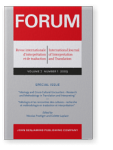Translation as an Ethical Action
Les changements sociétaires du vingtième siècle ont créé ce que Zygmunt Barman appelle des temps liquides caractérisés par la richesse de l’hybridité et les problèmes qui en découlent. Aujourd’hui tout particulièrement la traduction est appréhendée comme un acte idéologique. Face à la mondialisation et aux mutations sociales qui reflètent les changements philosophiques et scientifiques, le concept de la traduction s’élargit et l’image du pont ne suffit plus pour parler du traducteur. La question du rôle du traducteur se pose alors par rapport à l’éthique et l’on peut s’interroger sur l’autorité du traducteur, sur ce qu’est une traduction ‘responsable’ et sur les limites éthiques du rôle de traducteur.
References (44)
Appiah, K. A. (2000 [1993]). “Thick Translation”, The Translation Studies Reader, Lawrence Venuti (ed.), London and New York: Routledge, 417–429.
Arrojo, R. (1998). “The Revision of the Traditional Gap Between Theory & Practice & the Empowerment of Translation in Postmodern Times”, The Translator, 4, 1. 

Baker, M. (2006). Translation and Conflict, London: Routledge. 

Bassnett, S. (2007). “Culture and Translation”, in Piotr Kuhiwczak and Karin Littau (eds) A Companion to Translation Studies, Clevedon: Multilingual Matters, 13–23. 

Bassnett, S. (1999). “Translation 2000 –Difference and Diversity” Textus. English Studies in Italy, vol. XII, núm. 2: 213–218.
Bassnett, S. (1998). “When is a Translation Not a Translation?”, in André Lefevere and Bassnett, Susan (19nn) Constructing Cultures. Essays on Literary Translation, Clevedon: Multilingual Matters.
Barsky, R. (1996). The Interpreter as Intercultural Agent in Convention Refugee Hearings, The Translator 2 (1), 45–63. 

Bauman, Z. (2007). Liquid Times. Living in an age of uncertainty, Cambridge: Polity Press.
Bauman, Z. (2002). La cultura como praxis, Barcelona: Paidós. Trans. Albert Roca.
Berk-Seligson, S. (2002 [1990]). The Bilingual Courtroom, Chicago: The University of Chicago Press.
Cronin, M. (2006). Translation and Identity, London: Routledge. 

Cronin, M. (2003). Translation and Globalization, London: Routledge.
Cronin, M. (2000). Across the Lines: Travel, Language, Translation, Cork: Cork University Press.
Cunico, S. & Munday, J. (2007). Translation and Ideology. Encounters and Clashes, The Translator. Special Issue 13, 2.
Eco, U. (2003). Mouse or Rat? Translation as Negotiation, London: Phoenix.
Eco, U. (2003b). Dire quasi la stessa cosa. Esperienze di traduzione, Milan: Studi Bompiani.
Eco, U. (1994). Signo, Barcelona: Labor. Trans. Francisco Serra.
Garre, M. (1999). Human Rights in Translation. Legal Concepts in Different Languages, Copenhagen Business School Press.
Gentzler, E. (2008). Translation and Identity in the Americas. New Directions in Translation Theory, London and New York: Routledge.
Hale, S. (1997). The Treatment of Register Variation in Court Interpreting, The Translator 3 (1): 39–54. 

Hardwick, L. (2000). Translating Words, Translating Cultures, London: Duckworth.
Hermans, T. (2006). Translating Others, Manchester: St. Jerome.
Hermans, T., ed. (2002). Crosscultural Transgressions, Manchester: St. Jerome.
Hermans, T. (2007). The Conference of the Tongues, Manchester: St. Jerome.
Kim, S. (2003). The Interpreter, New York: Picador.
Koskinen, K. (2000). Beyond Ambivalence. Postmodernity and the Ethics of Translation, Academic Dissertation, Tampere: University of Tampere.
Krouglov, A. (1999). “Police Interpreting: Politeness and Sociocultural Context” The Translator 5 (2): 285–302. 

Lambert, J. (1995). “Literatures, Translation and (De)Colonization”, in Theresa Hyun and José Lambert (eds) Translation and Modernization, Tokyo: Tokyo University Press: 98–117.
Maier, C. (2007). “The Translator’s Visibility: The Rights and Responsibilities Thereof”,
apud
Myriam Salama-Carr (2007): 253–266. 

Ruano, M. & Rosario, M. (2006). La transmisión de la cultura en traducción jurídica: nuevas estrategias, éticas alternativas in María Gracia Torres Díaz y Marie-Ange Bugnot (eds.), Traducción y cultura. El referente cultural en la comunicación especializada, Málaga: Encasa: 161–200.
Ruano, M. & Rosario, M. (2009). Aproximaciones críticas a la traducción jurídica, Granada: Comares.
Maryns, K. (2005). Displacement in Asylum Seekers’ Narratives in Mike Baynham and Ana De Fina (eds) Dislocations/Relocations: Narratives of Displacement, Manchester: St. Jerome, 174–196.
Moeketsi, R. H. (1999). Redefining the Role of the South African Court Interpreter Proteus: Newsletter of the National Association of Judiciary Interpreters and Translators, vol. 21, nos. 3–4.
Morris, R. (1998). Justice in Jerusalem –Interpreting in Israeli Legal Proceedings, Meta 43, 1: 110–118. 

Ricoeur, P. (2005). Sobre la traducción, Barcelona: Paidós. Trans. Patricia Willson.
Said, E. (1996). Representations of the Intellectual, New York: Vintage.
Salama-Carr, M. (2007). (ed.) Translating and Interpreting Conflict, Amsterdam: Rodopi. 

Snell-Hornby, M. (1997). “How Many Englishes? Lingua Franca and Cultural Identity as a Problem in Translator Training”, in Horst W. Drescher (ed) Transfer: Übersetzen-Dolmetschen-Interkulturalität, Frankfurt: Peter Lang: 279–290.
Sontag, S. (ed.) (2007). Al mismo tiempo. Ensayos y conferencias, Barcelona: Mondadori. Trans. Aurelio Major.
Tymoczko, M. (2007). Enlarging Translation, Empowering Translators, Manchester: St. Jerome.
Tymoczko, M. (2003). “Ideology and the Position of the Translator: In What Sense Is a Translator ‘In-Between’”, in María Calzada (ed) Apropos of Ideology. Translation Studies on Ideology –Ideology in Translation Studies, Manchester: St. Jerome: 181-201.
Vidal, M. C. Á. (2007a). Traducir entre culturas, Frankfurt: Peter Lang.
Vidal, M. C. Á. (2007b). “Resisting Through Hyphenation: The Ethics of Translating (Im)pure Texts”, in Ana Manzanas (ed.) Border Transits: Literature and Culture across the Border, Amsterdam and New York: Rodopi: 225–242. 

Vidal, M. C. Á. (2005). En los límites de la traducción, Granada: Comares.
Cited by (2)
Cited by two other publications
CARRASCO, Cristina
2019.
«Tu cuerpo debe ser escuchado»: la postraducción del cuerpo femenino.
CLINA: Revista Interdisciplinaria de Traducción, Interpretación y Comunicación Intercultural 5:1
► pp. 131 ff.

This list is based on CrossRef data as of 2 august 2024. Please note that it may not be complete. Sources presented here have been supplied by the respective publishers.
Any errors therein should be reported to them.
